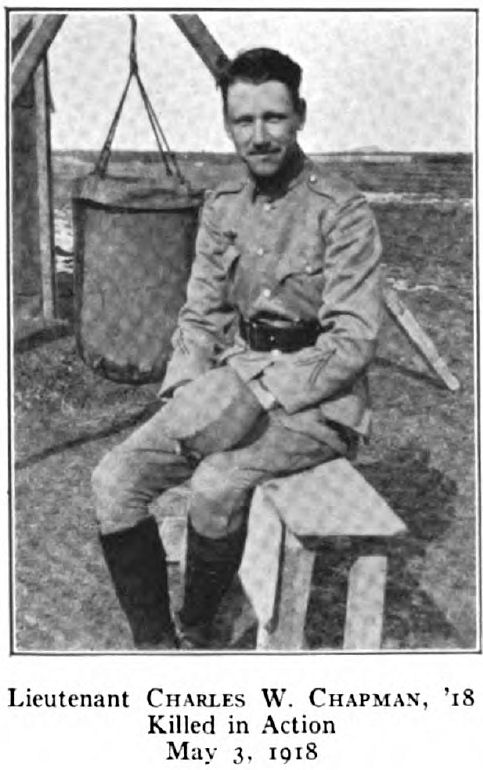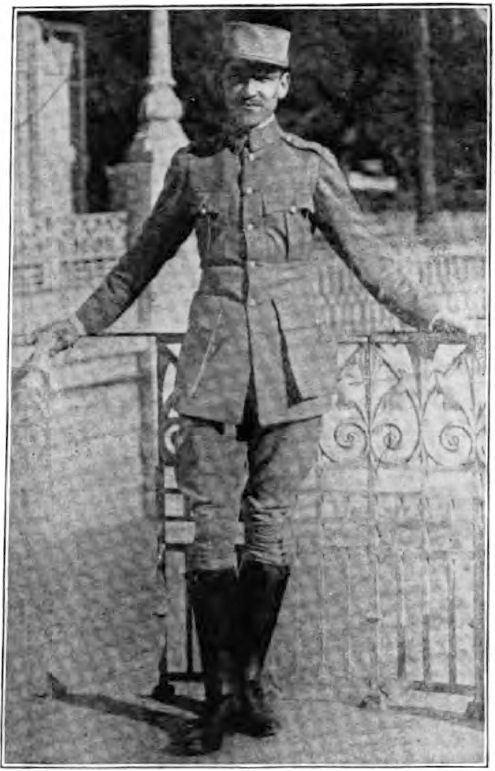|
Nous avons noté à l'article
Combats aériens - 1914-1918 (Suite),
la mort le 3 mai 1918 du pilote américain Charles W. Chapman Jr,
second lieutenant du 1er groupe de chasse de la 94ème
escadrille, abattu en flammes près d'Autrepierre. Voici quelques
compléments biographiques, où l'on apprend qu'il aurait été
inhumé près de Remoncourt par les Allemands.
The Amherst
memorial volume
A record of the contribution made by Amherst College and Ahmerst
Men in the World-War 1914-1918
Claide M. Fuess
Amherst College, 1926
CHARLES WESLEY CHAPMAN, '18
O dauntless youth, O soul
of fire,
Enskied, you have a winged pyre;
You fell to earth enwrapped with flame:
You fell, but from your ashes rise
What consecrates your sacrifice, -
The honor of your country's name!
Harry Leroy Haywood
Second Lieutenant Charles
Wesley Chapman was the first Amherst man to fall in action
during the World War. Born at Waterloo, Iowa, he attended the
West High School in that town, where he had a notable record as
an athlete. At Amherst, which he entered in 1914, he was
Business Manager of the Olio, played on his class basketball
team, and joined Phi Delta Theta. In the spring of 1917, when he
had not completed his junior year, he enlisted in the
Franco-American Ambulance Corps, sailing on May 19; but when he
reached France, he secured a transfer almost immediately to
aviation, and, after a course of training at Avord, Pau, Cazaux,
and Plessis-Belleville, became a member of the 94th Aero
Squadron in the famous Lafayette Escadrille. In February, 1918,
he received his commission as Second Lieutenant, and shortly
afterward he christened his own machine " Lord Jeff."
Lieutenant Chapman's letters to his family and friends, which
have been printed in a pamphlet for private circulation,
comprise an exceedingly interesting account of the training for
air combat. When he was still comparatively a novice, he wrote:
"You asked me to tell you something about the 'sensations' of
flying. As a source of sensation I think it is a fizzle, -
nothing to compare with a close game of golf or chess. I have
found myself at times on the point of drowsiness when some few
thousand metres in the air and have wished fervently I could go
down. As for feeling thrilled because of height, it is
surprising how safe you feel strapped in a 15-metre Nieuport and
so high that you look like a speck from the ground. The highest
that I have been is 5000 metres (16,000 feet) and I got no
particular sensation of height at all. The greatest
sensation of height I ever had was the first time I took a
machine ten metres off the ground. When I felt myself pass into
space and looked down at the ground, it looked as far from me as
the earth must look to the angels."
In a letter dated April 22, 1918, he told of his first
experience in action:
"Well, I have been baptized with fire. I have made my first
patrols. My initiation took place from 6 to 7 A. M. three days
ago. ... I was over the lines for an hour learning the sector.
Finally I decided to go down and see where I was. ... I cut my
engine and came down through the clouds. Just as I came out of
the clouds I heard a crack ! crack ! I looked off to one side
and saw small puffs of black smoke which I knew were Boche anti-aircraft
guns exploding. A second later I saw red streaks going past me
on the other side and I knew that these were the tracer bullets
from the machine guns. I looked down at the ground and saw that
I was exactly over the German trenches. I put on my motor and
headed for the nearest cloud. It couldn't have taken me more
than a minute to get to it but it sure seemed long. All the time
I could hear the shells exploding and now and then see another
streak of a tracer. . . . When I had finally landed I looked
over my plane. There wasn't a bullet hole in it."
On May 3, 1918, Chapman fought his last spectacular battle. Five
American pilots were patrolling at dawn over the German lines,
Chapman being the youngest of the group, by whom he was always
known as " the kid." The official account states that five enemy
planes - four monoplanes and one biplane - were sighted and
pursued. Chapman, attacking the biplane, finally shot it down.
While he was thus engaged, one of the enemy monoplanes
disengaged itself and, having the advantage of a higher
altitude, swooped down upon him. The two planes, inextricably
entangled, fell in flames behind the German lines. The American
aviators were naturally very proud of the daring spirit which
Chapman displayed. Norman Hall said at the time, "Poor Chapman
had tough luck. He's the first now. It's a gamble who will be
the next, but no one is worrying. It's a great life while it
lasts." His father was later notified that Lieutenant Chapman
had been buried with military honors by the Germans near
Remoncourt, on the Franco-German border but in French territory,
with a cross over his grave.
Lieutenant Chapman was posthumously awarded the Distinguished
Service Cross by the Commander-in-Chief, with the following
citation:
"On May 6, 1918, in the region of Autrepierre, while on patrol
duty, he courageously attacked a group of four monoplanes and
one biplane, and succeeded in bringing down one before he
himself was shot down in flames."
He received also a citation from General Gerard, commanding the
9th French Army. Lieutenant James A. Meissner, one of his
comrades in the squadron, wrote Chapman's mother:
"The whole squadron feels his loss deeply, for constant
cheerfulness makes many friends and lightens many hardships. I
do not doubt but that he died with a smile on his lips,
confident in the success of his attack and glorying in the
thrill of an air battle. Nothing can be more consoling to you
than that he was doing his utmost for his country in the service
of which none but the best are
found, - the air fighters."
Major Hueffer, his Commanding Officer in the First Pursuit Group
of the 94th Aero Squadron, wrote to his father:
"Allow me to extend to you my sincere sympathy at the loss or
capture of your very gallant son, whom I considered one of the
the most competent and courageous of our pilots."
The Amherst Student, in commenting editorially on Chapman's
death, had the following paragraph:
"Quiet, congenial, helpful, Chapman lived among us and made a
host of friends by his sincerity and kindness. He was one of
those men always ready and able to do his share. The honor he
won for himself was the recognition and respect of his college
mates for his pleasing and worthy personality."
Amherst men will always be glad to remember that the " Lord
Jeff," although battling against overwhelming odds, did account
for one at least of the enemy before it fell; and Lieutenant
Chapman's name will long be cherished by those who admire deeds
of heroism.

The Lafayette
flying corps
Ed. by James Norman
Ed. 1920
SERVICE RECORD
Charles W. Chapman, Jr.,
Waterloo, Iowa.
Service in French Aviation:
Date of enlistment: June 10, 1917.
Aviation Schools: June 16, 1917, to February, 1918, Avord, Pau,
Cazeaux, G.D.E.
Breveted: October 30, 1917 (Caudron).
Final Rank: Caporal.
Service in U.S. Aviation:
Commissioned Second Lieutenant: February 21, 1918.
At the Front: 94th Pursuit Squadron, March 3 to May 3, 1918.
Killed in combat: (Toul Sector) May 3, 1918.
Decorations:
Distinguished Service Cross.
Croix de Guerre, with Palm.
CITATIONS
G.H.Q., A.E.F.
On May 3, 1918, in the region of Autrepierre, France, while on
patrol duty, he courageously attacked a group of four monoplanes
and one biplane and succeeded in bringing one down before he
himself was shot down in flames.
By Command of General Pershing
Sous-Lieutenant Chapman, Charles Wesley, Pilote Escadrille
Americaine N° 94
Glorieusement tombé au cours d'un combat contre un groupe ennemi
après avoir abattu un de ses adversaires en flammes.
CHARLES W. CHAPMAN, Jr.
Those of us who were with
Chapman at Pau will always remember an incident that threw light
on the determination concealed beneath his modesty and reserve
of manner. It was in the acrobatics class,
when man after man was sent up alone in the 13-meter Nieuport to
do his first spins and aerial summersaults. At last, Chapman's
turn came, and up he went to spin and flip with the best of us -
but when he landed those who gathered around the machine noticed
that his face was white and that he staggered as he walked. That
evening he told us - the first spin had made him deathly ill,
his head swam, and the sky went black before his eyes. In this
condition, expecting every moment to faint, he had finished with
honors the full course of acrobatic flying. We urged him to
apply for two-seater work where trick flying is not required,
but he persevered and soon overcame his attacks of faintness. On
the 3d of May, 1918, near Autrepierre in Lorraine, Chapman died
as he had lived, cleanly and gamely fighting till he was shot
down within the enemy lines.
 |













